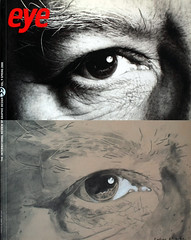Spring 2000
Invasion of the issue-snatchers
A disturbing 'campaign' by a clothing manufacturer blurs the line between editorial and advertising. Critique by Rick Poynor
My eight-year-old daughter was unsettled. She had just seen a Benetton advertisement hoarding at the end of our street with the words ‘sentenced to death’ stamped in big, black letters across a picture of an Afro-American man. ‘What does it mean?’ she asked. I hastened to assure her that we no longer have the death penalty in Britain, and that most civilised countries now regard such a thing as completely unacceptable. Then I began to try to explain why the American justice system decrees that Jerome Mallett, the man on the billboard, must die.
Does anyone still doubt the huge power of street advertising to mess with our heads? You could easily overlook Benetton’s broadsheet newspaper ads showing the same images. You could surf the Web forever and never stumble across the Benetton website, carrying the full ‘We, on death row’ campaign (www.benetton.com/deathrow). Even this is more likely than accidentally seeing the catalogue. I broke the habit of a lifetime and visited my local branch of Benetton to see if they had piles of this publication for the Saturday shopper. No, not a single copy. In the colourful, fluffy, cuddly surroundings of the shop, the idea that the same outfit should be mounting such a campaign (and all the previous campaigns) was frankly incredible.
Two and a half years in the making, ‘We, on death row’ is a disturbing document and an impressive piece of work. The us has executed approximately 600 people in the past 25 years. American journalist Ken Shulman travelled the country and interviewed 25 men and one woman condemned to die. Benetton creative director Oliviero Toscani took their pictures. The authors do not excuse their crimes, but they want us to see their faces and understand who they are. The condemned are remorseful, self-pitying, blank, haunted by failure, consumed by fear, accepting of the almost inevitable and sometimes wise. Jerome Mallett once dreamed of doing illustrations for advertising; he has been waiting for his lethal injection since 1986. Shulman argues that these state-sanctioned gassings, poisonings and electrocutions, which few American politicians dare to question for fear of losing votes, cheapen citizens and contaminate all who are involved.
My daughter, struggling to come to terms with the idea of legalised killing, found a moment to wonder what any of this has got to do with clothes. Always the same question: if we ever stop asking it, we will be in deep trouble because at that point the dividing line, grasped by even the eight-year-old mind, between advertising and news will have dissolved once and for all. Toscani impatiently dismisses such scruples. He argues that the unexpected eruption of this material in a new ‘inappropriate’ context, with a Benetton logo attached, forces viewers jaded by years of horror on the nightly news to pay attention. And sure enough, here we are talking about Benetton again. He says that most editorial is heavily compromised by the advertising that supports it. The dividing line is already blurred. Blur it some more.
While Benetton’s campaigns are still unusual in their support for controversial causes and ideas, they are part of a relentless trend – nailed in the book No Logo by Naomi Klein – by which advertisers attempt to co-opt cultural space as a way of boosting their brands. Increasingly, superbrands such as Benetton see themselves as being in the business of culture-creation. The result, as this trend develops, will be to make culture itself appear to exist at their behest. Toscani’s repeated jibes at the ‘stupidity’ of most advertising dare other advertisers to follow his lead. If they did so, Benetton would lose the leverage that comes from being one of a kind and fragile but vital distinctions between commercial interests and independent commentary would suffer irreparable damage as corporations routinely meddled in serious public matters for their own ends.
It’s hard, though, if you read ‘We, on death row’, to reject Benetton’s initiative out of hand. Jerome Mallett hopes his girlfriend will see the catalogue. He seems resigned to his fate. But the campaign comes too late for Harvey Lee Green, photographed holding his Bible. He was executed in September 1999 after seven years on death row.
Rick Poynor, writer, founding editor of Eye, London
First published in Eye no. 35 vol. 9, 2000
Eye is the world’s most beautiful and collectable graphic design journal, published quarterly for professional designers, students and anyone interested in critical, informed writing about graphic design and visual culture. It is available from all good design bookshops and online at the Eye shop, where you can buy subscriptions and single issues.

